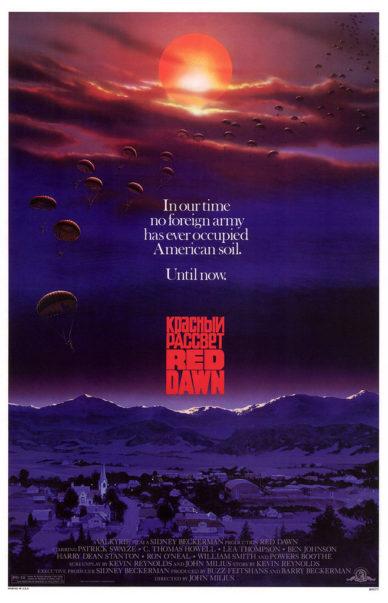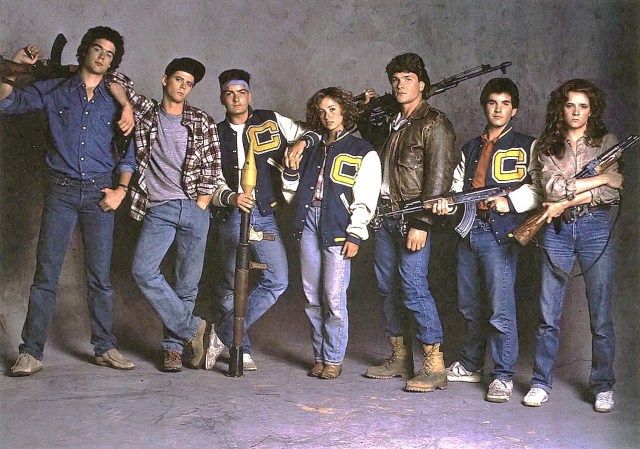 “Better dead than red” cinema got a memorable 1980s rethink in RED DAWN, a “what-if?” narrative about a Russian invasion of the US, courtesy of Hollywood’s foremost right wing provocateur John Milius. This 1984 MGM production began as a screenplay called TEN SOLDIERS by Kevin Reynolds (the future director of FANDANGO and WATERWORLD), which spun a LORD OF THE FLIES-like tale of young folk giving way to infighting while resisting the invasion. Milius, working in close proximity to then secretary of state (and longtime MGM board member) Alexander Haig, amplified the script’s patriotic elements and played down the complexity, winding up with a no-frills flag waver that effectively updates similarly themed oldies like INVASION USA (1952) and IF FOOTMEN TIRE YOU, WHAT WILL HORSES DO? (1971).
“Better dead than red” cinema got a memorable 1980s rethink in RED DAWN, a “what-if?” narrative about a Russian invasion of the US, courtesy of Hollywood’s foremost right wing provocateur John Milius. This 1984 MGM production began as a screenplay called TEN SOLDIERS by Kevin Reynolds (the future director of FANDANGO and WATERWORLD), which spun a LORD OF THE FLIES-like tale of young folk giving way to infighting while resisting the invasion. Milius, working in close proximity to then secretary of state (and longtime MGM board member) Alexander Haig, amplified the script’s patriotic elements and played down the complexity, winding up with a no-frills flag waver that effectively updates similarly themed oldies like INVASION USA (1952) and IF FOOTMEN TIRE YOU, WHAT WILL HORSES DO? (1971).
…a no-frills flag waver …
According to Milius, the politics of RED DAWN led to him being blacklisted by Hollywood (the fact that his subsequent films FAREWELL TO THE KING and FLIGHT OF THE INTRUDER were costly flops might also have had something to do with the shunning), yet it proved influential in a number of ways. Firstly, it inspired a slew of young-people-taking-on-the-Commies films (such as IRON EAGLE and THE RESCUE), and bore the newly-minted PG-13 rating, which has gone on to become the “rating of champions.” It’s also influenced reality, having had several military operations named after it and the term “Wolverine,” coined in RED DAWN, becoming a rallying cry by Ukrainians resisting the 2022 Russian invasion. And yes, there was a 2012 remake, which replaced Russians with North Koreans, and, unlike the previous film, made no impact whatsoever.
Having viewed RED DAWN during its initial theatrical run, I can attest that its early scenes were terrifying. These scenes—following a lengthy textual screed detailing the dissolution of NATO and a socialist takeover of Mexico, which leaves the United States without any allies—depict Russian soldiers parachuting into a small Colorado town (actually Las Vegas, New Mexico), as viewed by high schoolers. These kill-happy Russians promptly shoot a teacher (Milius regular Frank McRae), followed by several students.
…the term “Wolverine,” coined in RED DAWN, becoming a rallying cry by Ukrainians resisting the 2022 Russian invasion.
Many of the surviving youngsters, including the brothers Jed and Matt (Patrick Swayze and Charlie Sheen) and their pal Robert (C. Thomas Howell), dash off to a forest overlooking the town. There Jed becomes the de facto leader of a group that dubs itself the Wolverines (after their school mascot) and takes to launching sneak attacks on the occupying Russians—who in the meantime herd the townspeople into prison camps and mow ‘em down as they sing “America the Beautiful.”
Joining the Wolverines are two traumatized young women (Lea Thompson and Jennifer Grey) and Lt. Col. Tanner (Powers Boothe), a fighter pilot shot down by Cubans who fills the kids in on the state of the union. Several major cities, he claims, have been nuked, and Soviet invaders have taken over much of the rest of the country.
Things inevitably wind down for the Wolverines, as the formerly steely and unflappable Jed becomes increasingly unhinged. In the film’s most powerful scene, a traitor to the Wolverines stands to be executed by Jed, who can’t go through with the killing—only to have his formerly sensitive ally Robert shock everyone by abruptly performing the execution himself. Not that this matters, as the Wolverines are eventually overrun by their enemies, leaving just two survivors and a plaque to mark their passing (which Milius claims was intended as an anti-war statement, with a plaque being scant compensation for the Wolverines’ ordeal).
Viewed from a multi-decade vantage point, none of the above makes much sense. It seems inexplicable that the occupying Russians never think to search the mountains for the Wolverines, who all appear impossibly clean and well-groomed for forest dwellers.
The acting is problematic. Milius (who once likened actors to trained dogs) was never very skilled with directing actors, which is a particular problem in a film whose cast was largely inexperienced. The performers have a tendency toward the shrill and histrionic, with Milius’ sole attempt at alleviating those things being the cutting back of the “emotional life” of its characters. That was according to Powers Boothe, who also claimed his role was largely “negated” due to postproduction editing.
Milius (who once likened actors to trained dogs) was never very skilled with directing actors, which is a particular problem in a film whose cast was largely inexperienced.
Yet there’s a reason the film has never gone away. Quite simply: it’s fun, providing a great deal of rousing violence without irony or pretention, and spirited musical accompaniment by Basil Poledouris (which followed an equally fitting Poledouris score for Milius’ CONAN THE BARBARIAN).
John Milius was probably the only director who could have made this material work, turning out an admirably no-nonsense, old school actioner that never overcomes its early 1980s trappings (it’s impossible not to be distracted by the very of-the-period hairstyles) but does its utmost to make the best of them.
Vital Statistics
RED DAWN
MGM/UA
Director: John Milius
Producers: Buzz Feitshans, Barry Beckerman, Sidney Beckerman
Screenplay: Kevin Reynolds, John Milius
Cinematography: Ric Waite
Editing: Thom Noble
Cast: Patrick Swayze, C. Thomas Howell, Charlie Sheen, Powers Boothe, Harry Dean Stanton, Ron O’Neal, William Smith, Lea Thompson, Brad Savage, Jennifer Grey, Ben Johnson, Lois Kimbrell, Vladek Sheybal, Frank McRae, Roy Jenson, Pepe Serna, Lane Smith

